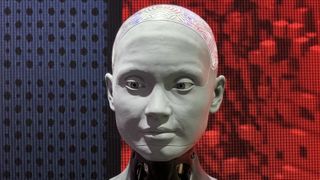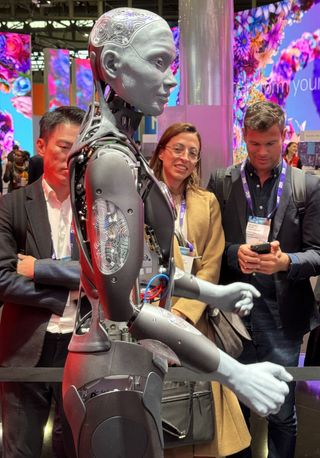I saw the most advanced robot in the world – and it’s creepy
Cast your mind back to 2023 and you may remember seeing Ameca, the so-called most advanced robot in the world, appearing on British TV This morning and making headlines everywhere. Now Ameca is back, with a second-generation version showing off at MWC 2024, complete with even more realistic facial expressions.
I was first alerted to Ameca’s presence at the show when I saw a crowd of staring MWC attendees, fascinated by something. Naturally, I walked over to investigate and there I beheld Ameca in all his semi-skeletal glory, answering questions barked at her by MWC folks – leaving me with the eerie feeling that I was on the pre-production set of Ex Machina.
The robot uses generative AI to respond to questions in real time, ranging from simple questions like “how old are you?” to crazier questions like ‘can you dance?’ – reader, Ameca can dance, and probably better than the average nightclub goer.
All very nice, but it was only when Ameca was asked if there were any emotions in it that the demo became truly impressive. It responded with a whole range of facial expressions, all of which looked very realistic, and in that moment I could really see that robots were going to be part of our future.
Ameca encountered a few questions, not least because she was trying to keep up with a barrage of clues and questions. But the natural language comprehension was quite smooth and the expressions it put out along with the answers were realistic enough that you wouldn’t feel like you were just talking about a jumble of cables, chips and servo motors. There is also still a way to go before the ‘uncanny valley’ feeling is overcome.
Nevertheless, it’s impressive to see Ameca working in the (robot) flesh, and not as creepy as you might think – of course, you can’t think about the mediocre stuff I robot film, but that feeling is quickly put aside when you see Ameca at work.
Ameca’s creator, UK-based Engineering Arts, doesn’t intend for robots to replace humans – which is a relief, as there are already plenty of concerns that generative AI could replace jobs. Rather, the company wants to use it to advance robotic science. That said, the company thinks Ameca will eventually be used in the real world in addition to humans as a form of robot receptionist or social assistant.
Such a future is probably still far away, but Ameca will serve as a platform for AI technology, which in turn could produce smarter robots that could be truly useful to our society. That, or we’ll all have robot butlers soon.



